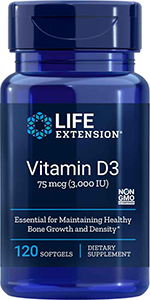RECOMMENDATION NO 4

Optimize Vitamin D Blood Level
Vitamin D is a fat-soluble prohormone that effects the expression of more than 200 genes in your body.1 It is essential for optimal health. And yet there is a widespread vitamin D deficiency!
You can bring blood vitamin D to optimal levels2 through repeated sun exposure. But sunscreens and low light in winter make that difficult. And the American Academy of Dermatology has reaffirmed that vitamin D should not be obtained from unprotected ultraviolet (UV) exposure from the sun or indoor tanning devices.
So Life Extension recommends that you supplement with 5,000 IU to 8,000 IU of vitamin D3 daily. And take a 25-hydroxyvitamin D blood test after 3 months to assess and adjust your dosage so your optimal blood levels will be between 50–80 ng/mL year-round.
Once vitamin D3 is produced in the skin or consumed in food, it’s converted in the body to a metabolically active form known as calcitriol that does far more than just regulate your body’s calcium balance.3 Vitamin D affects cell differentiation, immunity, insulin secretion, blood pressure regulation, etc.4-47 So maintain optimal levels of blood vitamin D effectively and inexpensively by supplementing daily with 5,000 IU daily.
Life Extension customers can maintain optimal levels of blood vitamin D effectively and inexpensively by supplementing daily with a 3,000 IU softgel.
Caution: Individuals consuming more than 2,000 IU/day of vitamin D (from diet and supplements) should periodically obtain a serum 25-hydroxy vitamin D measurement. Do not exceed 10,000 IU per day unless recommended by your doctor. Vitamin D supplementation is not recommended for individuals with high blood calcium levels.
+
1. Genome Res. 2010 Oct;20(10):1352-60.
2. Endocrinol Metab Clin North Am. 2010 Jun;39(2):287-301.
3. Hautarzt. 2004 May;55(5):446-52.
4. Am J Clin Nutr. 2004;79(3):362-371.
5. Am J Clin Nutr. 2008 Aug;88(2):570S-577S.
6. http://ods.od.nih.gov/factsheets/VitaminD-HealthProfessional/ Accessed
March 13, 2014
7. Drugs Aging. 2007;24(12):1017-29.
8. Trends Endocrinol Metab. 2002 Apr;13(3):100-5.
9. J Neurosci Res. 2000 Nov 1;62(3):374-82.
10. Neuropharmacology. 2001 May;40(6):761-71.
11. Neurol Sci. 2009 Jun;30(3):207-12.
12. Trends Endocrinol Metab. 2002 Apr;13(3):100-5.
13. Neurosci Lett. 1996 Oct 4;216(3):183-6.
14. J Infect Dis. 2011 Jan 1;203(1):122-30.
15. J Nutr. 2011 Mar;141(3):476-81.
16. J Biol Chem. 2010 Dec 10;285(50):38751-5.
17. Arterioscler Thromb Vasc Biol. 2010 Dec;30(12):2495-503.
18. PLoS One. 2010 Sep 23;5(9):e12925.
19. Immunol. 2010 Sep;105(3):191-9; quiz 200-2, 217.
20. J Immunol. 2010 Oct 15;185(8):4948-58.
21. Am J Physiol Heart Circ Physiol. 2010 Oct;299(4):H1226-34.
22. Hypertension. 2011 Jan;57(1):63-9.
23. Diabetologia. 2010 Oct;53(10):2112-9.
24. Ann Rheum Dis. 2010 Aug;69(8):1448-52.
25. Appl Nurs Res. 2009 Aug;22(3):221-5.
26. Eur J Endocrinol. 2014 Feb 11. [Epub ahead of print]
27. Int J Health Sci (Qassim). 2013 Nov;7(3):267-75.
28. Sheng Li Xue Bao. 2014 Feb 25;66(1):30-6.
29. Public Health Nutr. 2014 Apr;17(4):823-6.
30. J Evid Based Dent Pract. 2014 Mar;14(1):39-41.
31. Anticancer Res. 2014 Mar;34(3):1163-6.
32. Ann Am Thorac Soc. 2014 Mar 6. [Epub ahead of print]
33. J Spec Oper Med. 2014 Spring;14(1):58-66.

